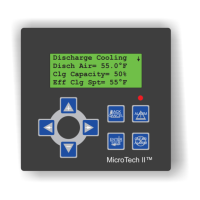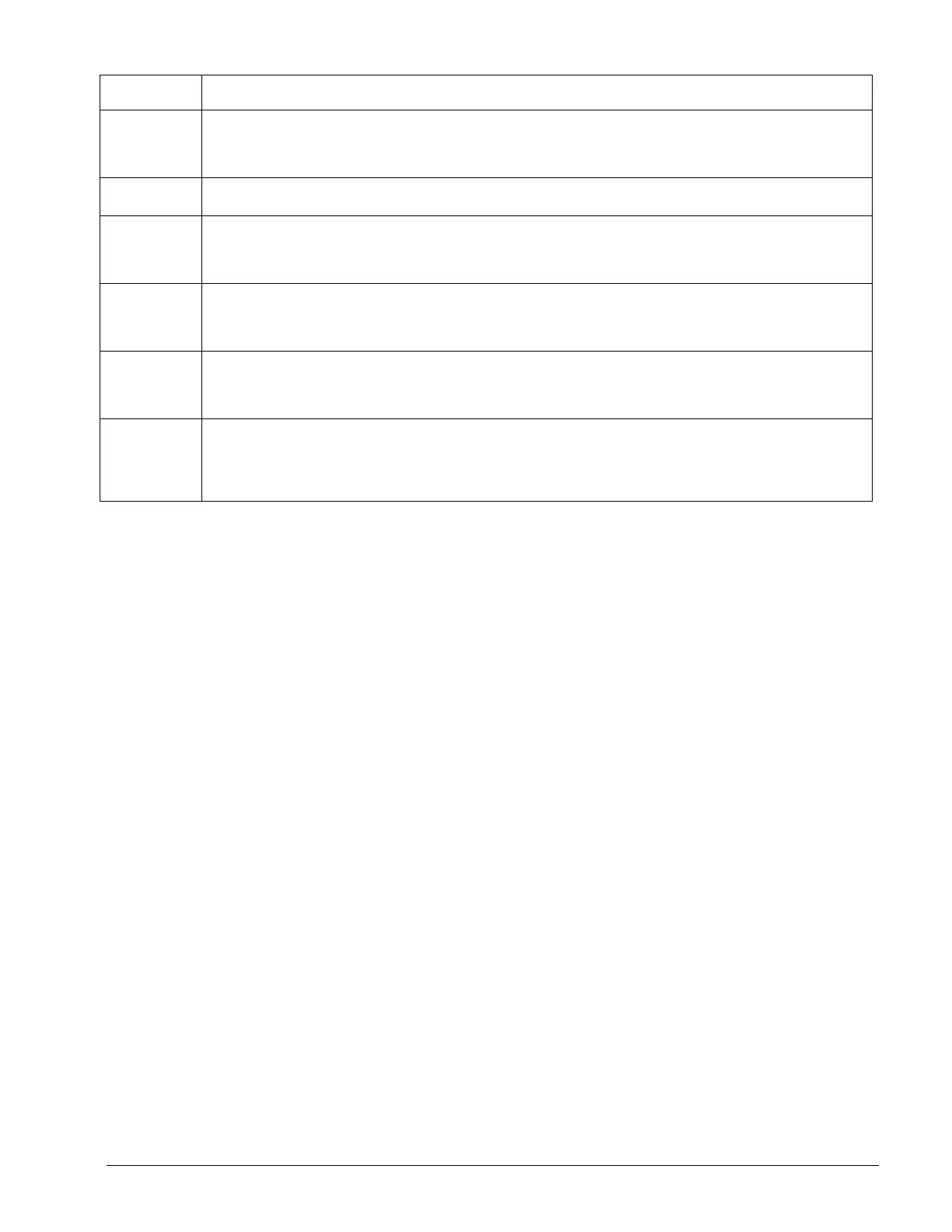OM 780-2 Page 37
Up Differential System Setpoint > Chiller Stage-Up Differential, the Next-ON chiller may be enabled. Range = 0 – 9.5°F (0 – 5.2°C). Default =
+1.0°F (+0.5°C)
Spare Capacity
Factor
This input sets the spare capacity multiplier required for the CSM to stage-down, which is used to reduce short cycling. If the
Active Capacity for the Next-OFF chiller < Spare Capacity Factor * (Sum of the Spare Capacity of all other running chillers), the
Next-OFF chiller may be disabled. Lowering this value reduces the possibility of short cycling and increases the possibility of
having more chillers running than is required to meet the load. Range = 0.50-0.95. Default = 0.90
Chiller Stage
Delay Time
This input sets the time that must expire after one stage-up/down event occurs before the next stage-up/down may occur. Range =
3 to 60 minutes. Default = 5 minutes
Decoupler
Stage-Up
Temperature
Differential
This value sets the decoupler line water temperature error required for the CSM to stage-up due to lack of primary chilled water
flow. If the Chiller Sequence Control Type = “Decoupled” and the Decoupler Temp > (Chilled Water Supply Temp + Decoupler
Stage-Up Temperature Difference, the Next-ON chiller may be enabled. Range = 0.0 – 9.5°F (0.0 – 5.2°C). Default = +2.0°F
(+1.1°C)
Decoupler
Stage-Down
Flow Rate
Factor
This input sets the spare primary flow multiplier required for the CSM to stage-down. If the Chiller Sequencing Control Type =
“Decoupled” and the Decoupler Line Flow Rate > (Decoupler Stage-Down Flow Rate Factor * (the Next-OFF Chiller’s Flow Rate
through its evaporator)), the Next-OFF chiller may be disabled. Raising this value reduces the possibility of short cycling and
increases the possibility of having more chillers running than is required to meet the load. Range = 0.75 – 1.50. Default = 1.10
Wait For
Evaporator Flow
Timer
This input tells the CSM how long to wait after a chiller has been enabled for flow to be proven by that chiller’s evaporator flow
switch. Also, the CSM waits for this timer to expire before checking for Off-Line chillers, this allows for the starting delays of
certain chillers (e.g. centrifugal) to exist without being recognized by the CSM as an Off-Line chiller at startup. Range = 160
seconds – Chiller Stage Delay Time. Wait For Evaporator Timer Default = 2 minutes 55 seconds.
Max Chiller
Stop-To-Start
Cycle Timer
This input tells the CSM the longest Stop-To-Start Cycle Timer Setpoint in any of the controlled chillers. After a chiller shuts
down normally it is unavailable to run until its Stop-To-Start Cycle Timer expires. The CSM will not enable a standby chiller if a
normal chiller is unavailable due to its cycle timer. If something happens to the chiller while the cycle timer is active to make it
unavailable after the cycle timer expires, this variable will detect that condition and allow a standby chiller to be enabled. Range
= 3 – 40 minutes. Default = 20 minutes.
Start-Up Control
When the chiller system starts, the CSM’s operating state changes from Off to Recirculate. If there is a cooling load pump,
the CSM proves that chilled water flow in the cooling load loop exists before leaving Recirculate and going to the On State.
Upon entering the On State, the CSM enables the first chiller. Once the first chiller is enabled, its controller starts the
primary chilled water pump, checks for evaporator water flow, and checks for a cooling load. The chiller starts if there is
flow and the leaving evaporator water temperature is greater than the Active Setpoint by more than the chiller’s Start Delta
variable.
After the first chiller starts, its controller increases cooling capacity as required, but only within the constraints of an active
Max Pull Down rate control (chiller unit controller function) and soft loading control (CSM function). Any active max pull
down rate or soft loading control can limit the chiller’s capacity and thus may delay chiller staging.
Standard Sequencing Logic
Standard sequencing logic is intended for constant flow primary-only chiller systems. A typical primary-only system is
shown in Figure 11. The distinguishing characteristic is that the primary pumps distribute water to the cooling loads. The
primary pump and evaporator piping arrangements are not distinguishing characteristics. Dedicated primary pumps and
parallel evaporators are shown in Figure 11, but common primary pump and series evaporators are also possible.

